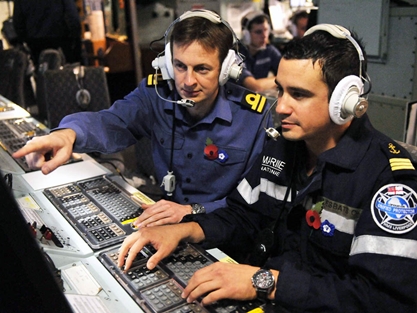‘THIS IS JUST THE BEGINNING…’ MAJOR ANGLO-FRENCH NAVAL EXERCISE ENDS IN THE MED

26/10/2012
The first test of the British and French Navies to create a combined task force ready to respond to global events ends today off the South of France. Exercise Corsican Lion has been a two-week work-out for the flagships of the UK – HMS Bulwark – and France – FS Charles de Gaulle – and their respective task groups.



The orange-red glow of the afterburner lights up just a few feet from the end of the angled flight deck as a Rafale jet powers skywards over the Mediterranean.
Within 60 seconds, another of France’s premiere strike fighters does likewise from the deck of her nation’s flagship.
Just a few yards off the aircraft carrier’s port side, HMS Northumberland, a giant White Ensign billowing as she scythes through the calm azure waters on a perfect autumn day.
Off the starboard bow, the FS Jean Bart cuts through the Med, an equally large Tricolore fluttering furiously from her main mast.
This is the ‘strike’ element of Exercise Corsican Lion – the first major test of forging an Anglo-French naval force which concludes today off the South Coast of France in front of political leaders from London and Paris, among them UK Defence Secretary Philip Hammond.
Ten minutes’ flight away, between Toulon and St Tropez, the core of Britain’s Response Force Task Group is either at anchor or ‘docked down’: HMS Bulwark, RFA Mounts Bay and the FS Mistral with their loading docks open to the Med, an airborne surveillance Sea King and Apache gunship from HMS Illustrious circle their mother, while HMS Montrose stands guard.
The main training element of Corsican Lion is now done: the de Gaulle providing aerial striking power, Bulwark choreographing landings on the eastern shores of the French Mediterranean isle.
That concluded on Tuesday and Wednesday. The rest of the week is about showing to senior military and political figures what the two nations’ navies and marines can do together.
Come 2016 there will be a Combined Joint Expeditionary Force at 30 days’ notice to sail on the orders of Whitehall and the Quai d’Orsay to respond to international crises and remain on station for up to three months.
There have been joint exercises between the Royal Navy and Marine Nationale over the past decade, but nothing on the scale of trying to create a joint Anglo-French naval force.
With around ten ships, over 30 jets, gunships and helicopters, Royal Marines of 3 Commando Brigade and their French counterparts – a force in all of over 5,000 men and women, 2,600 of them British – Corsican Lion is a big step down the road to forging that joint force.
“We are close neighbours and close partners. Corsican Lion mixes together our ships, submarines, aircraft, French soldiers, Royal Marines. The equipment on display is what we may wish to deploy in the next crisis,” said Fleet Commander Admiral Sir George Zambellas, watching the penultimate day of the exercise.
Britain’s second most senior naval officer said work to create the joint Anglo-French force had been “pleasing” but “challenges remained” to creating a combined expeditionary force. “Our work together continues.”
Capt Andrew Burns, Bulwark’s Commanding Officer, added:
“What we have here is a potent mix. We can sail 300 miles in a day.
"We could, for example, be off the west coast of Africa in a week for an evacuation. What you see here is a fleet in being.”
Corsican Lion has shown that some things work very well – the two navies and two marine forces do things differently and have different kit, but are both passionate about the sea and showing what a navy can do that an army or air force cannot.
“Put together, we have something greater than the sum of our parts,” said Lt Col Chris Hall, a senior Royal Marines amphibious warfare officer aboard HMS Bulwark.
The exercise has also shown that there’s still work to be done, particularly when it comes to communications.
Language hasn’t proven to be a major barrier – most of the French personnel speak English (rather better than vice versa) and have been able to talk over the different radio systems.
Sharing data – particularly important in 21st Century warfare – has proved to be more problematic, but nothing that cannot be resolved over the next 12 months.
“Working with the French has been hugely enjoyable and the two weeks together have been hugely beneficial. They are very forward thinking, very helpful,” said Cdre Paddy McAlpine, Commanding the Response Force Task Group from Bulwark.
“We understand what they can do. They understand what we can do. This is just the beginning.”
Source: Royal Navy, UK.
No comments:
Post a Comment